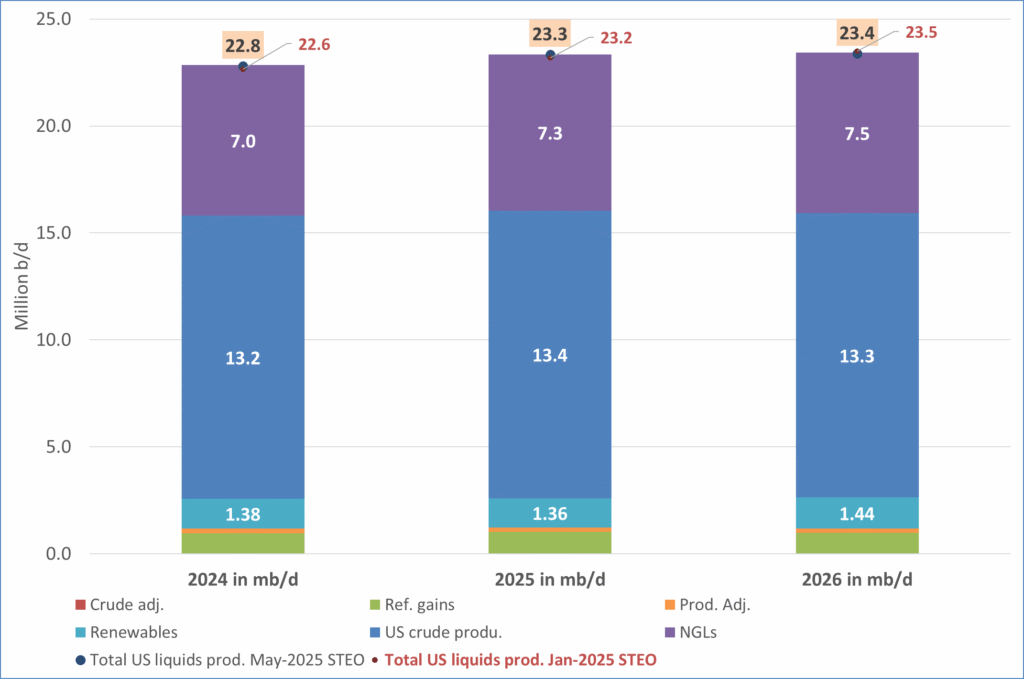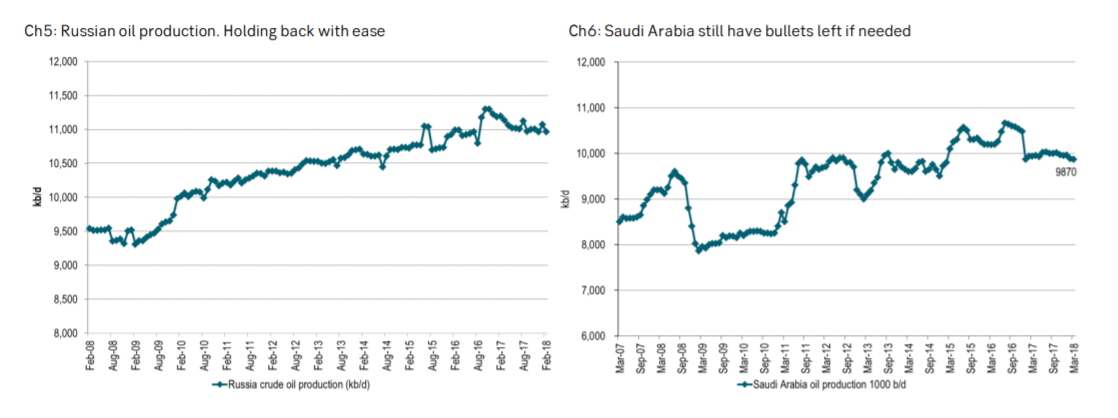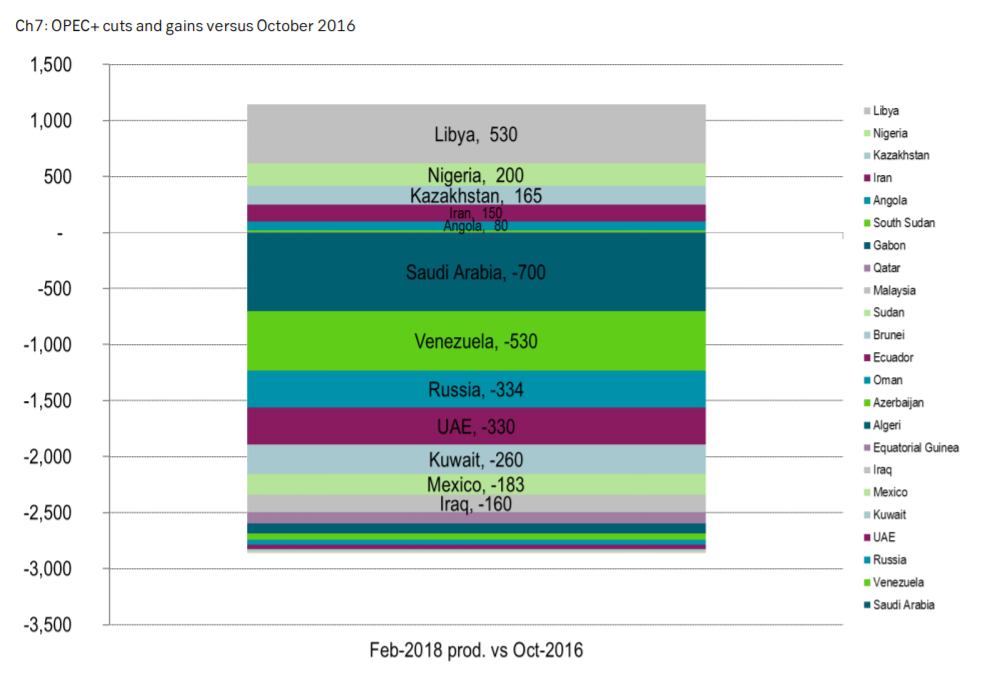Analys
Successful production cuts but exit is not so easy

 Brent crude oil is trading up 0.2% this morning to $71.5/bl supported by Kuwait’s statement that OPEC will discuss extending production cuts to 2019 at its June meeting in Vienna. Extending cuts to 2019 is not about driving inventories yet lower and the oil price yet higher. It is about avoiding inventories from rising back up again. OPEC+ has cut production, drawn down OECD inventories to just 24 million barrels above the rolling five year average in February with target in sight in May. Thus victory as such, but the group cannot place its deliberate cuts back into the market neither this year nor in 2019. The group is to a larger or lesser degree stuck with its cuts for the time being and in 2019. We estimate that deliberate cuts amounted to 2 m bl/d in February versus seasonally adjusted OECD inventory draw down of 0.2 m bl/d through Jan and Feb this year. This does not mean that US shale has OPEC+ up against the wall quite yet. Saudi Arabia for one still has plenty of ammunition left if needed. The group just cannot yet place its cuts back into the market. The main vulnerability is the OPEC+ cooperation. If that fell apart we would see rising inventories and falling oil prices. The rising tension in Syria is bullish if it leads to sanctions towards Russian oil exports but it would be bearish if it sows the seeds of division within the OPEC+ group. For now and in 2019 our view is that OPEC+ is in control of the oil market and it is not out of bullets even though it cannot exit cuts.
Brent crude oil is trading up 0.2% this morning to $71.5/bl supported by Kuwait’s statement that OPEC will discuss extending production cuts to 2019 at its June meeting in Vienna. Extending cuts to 2019 is not about driving inventories yet lower and the oil price yet higher. It is about avoiding inventories from rising back up again. OPEC+ has cut production, drawn down OECD inventories to just 24 million barrels above the rolling five year average in February with target in sight in May. Thus victory as such, but the group cannot place its deliberate cuts back into the market neither this year nor in 2019. The group is to a larger or lesser degree stuck with its cuts for the time being and in 2019. We estimate that deliberate cuts amounted to 2 m bl/d in February versus seasonally adjusted OECD inventory draw down of 0.2 m bl/d through Jan and Feb this year. This does not mean that US shale has OPEC+ up against the wall quite yet. Saudi Arabia for one still has plenty of ammunition left if needed. The group just cannot yet place its cuts back into the market. The main vulnerability is the OPEC+ cooperation. If that fell apart we would see rising inventories and falling oil prices. The rising tension in Syria is bullish if it leads to sanctions towards Russian oil exports but it would be bearish if it sows the seeds of division within the OPEC+ group. For now and in 2019 our view is that OPEC+ is in control of the oil market and it is not out of bullets even though it cannot exit cuts.
Brent crude oil is trading slightly lower morning at $71.3/bl after having been supported by Kuwait’s statement that OPEC will discuss extending production cuts to 2019 at its June meeting in Vienna. It is clear that the production cuts by OPEC+ has been successful in terms of drawing down global oil inventories and lifting prices in consequence. On average OECD inventories drew down about 0.75 m bl/d during the last 7 months of 2017 while they have only been drawing down 0.2 m bl/d through Jan and Feb this year. Both adjusted for seasonal trends. OPEC+ has delivered hard on its pledged cuts but with significant internal variations with respect to deliberate cuts, involuntary cuts and production increases. In comparison to the OECD drawdowns mentioned above the average deliberate cuts from Jan-2017 to Feb-2018 was 1.77 m bl/d and in February the deliberate cuts were 2.1 m bl/d (not counting individual gains and involuntary cuts). What is clear is that deliberate production cuts have been much larger than the draw downs in OECD inventories. So if it had not been for the cuts by OPEC+ then the global oil market would clearly still be subdued with a significant running surplus through 2017 and very, very high inventories today.
What OPEC+ would like would of course be to cut production, draw down inventories and then put production cuts back into the market. OECD commercial inventories in February only stood 24 million barrels above the 2013 to 2017 five year average. So victory as such.
However, OPEC+ is not in a position to place its deliberate production cuts back into the market. The group is for the time being more or less stuck with its cuts. It cannot get out. At least not yet and this is why the group needs to discuss extending production cuts to 2019 at its Vienna meeting in June 20/21/22. If it wants to avoid inventories from rising back up again in 2019 it will need to maintain cuts.
But OPEC does not have its back up against the wall yet. It still has more bullets left. Just look at Saudi Arabia. Yes, it has cut production by 0.7 m bl/d versus its October 2016 production of 10.6 m bl/d. But that means that it is still producing 9.9 m bl/d at the moment. In comparison its average production from 2005 to 2016 was 9.3 m bl/d with a low of 7.86 m bl/d at the start of the crisis year 2009. In other words it can easily deepen cuts if needed even though it is not obvious if it would do so alone without cooperating cuts by the rest of OPEC+. Thus vulnerability is along the lines of further OPEC+ cooperation and cohesion.
As long as the internal cooperation within OPEC and the wider OPEC+ is not falling apart the group still has the capacity and ability to hold the oil market, to hold the oil price both this year and next year. Total OPEC+ production in Feb-2018 stood at 49.5 m bl/d plus NGL thus accounting for more than 50% of global supply. OPEC+ is not home free to place its cuts back into the market again neither now or in 2019. Extending cuts to 2019 is not about driving inventories yet lower and the oil price yet higher. It is about avoiding inventories from rising back up again. If Venezuela declines more than expected or if US sanctions are revived towards Iran it may allow some return of deliberate cuts.
Analys
Brent crude ticks higher on tension, but market structure stays soft

Brent crude has climbed roughly USD 1.5-2 per barrel since Friday, yet falling USD 0.3 per barrel this mornig and currently trading near USD 67.25/bbl after yesterday’s climb. While the rally reflects short-term geopolitical tension, price action has been choppy, and crude remains locked in a broader range – caught between supply-side pressure and spot resilience.

Prices have been supported by renewed Ukrainian drone strikes targeting Russian infrastructure. Over the weekend, falling debris triggered a fire at the 20mtpa Kirishi refinery, following last week’s attack on the key Primorsk terminal.
Argus estimates that these attacks have halted ish 300 kbl/d of Russian refining capacity in August and September. While the market impact is limited for now, the action signals Kyiv’s growing willingness to disrupt oil flows – supporting a soft geopolitical floor under prices.
The political environment is shifting: the EU is reportedly considering sanctions on Indian and Chinese firms facilitating Russian crude flows, while the U.S. has so far held back – despite Bessent warning that any action from Washington depends on broader European participation. Senator Graham has also publicly criticized NATO members like Slovakia and Hungary for continuing Russian oil imports.
It’s worth noting that China and India remain the two largest buyers of Russian barrels since the invasion of Ukraine. While New Delhi has been hit with 50% secondary tariffs, Beijing has been spared so far.
Still, the broader supply/demand balance leans bearish. Futures markets reflect this: Brent’s prompt spread (gauge of near-term tightness) has narrowed to the current USD 0.42/bl, down from USD 0.96/bl two months ago, pointing to weakening backwardation.
This aligns with expectations for a record surplus in 2026, largely driven by the faster-than-anticipated return of OPEC+ barrels to market. OPEC+ is gathering in Vienna this week to begin revising member production capacity estimates – setting the stage for new output baselines from 2027. The group aims to agree on how to define “maximum sustainable capacity,” with a proposal expected by year-end.
While the IEA pegs OPEC+ capacity at 47.9 million barrels per day, actual output in August was only 42.4 million barrels per day. Disagreements over data and quota fairness (especially from Iraq and Nigeria) have already delayed this process. Angola even quit the group last year after being assigned a lower target than expected. It also remains unclear whether Russia and Iraq can regain earlier output levels due to infrastructure constraints.
Also, macro remains another key driver this week. A 25bp Fed rate cut is widely expected tomorrow (Wednesday), and commodities in general could benefit a potential cut.
Summing up: Brent crude continues to drift sideways, finding near-term support from geopolitics and refining strength. But with surplus building and market structure softening, the upside may remain capped.
Analys
Volatile but going nowhere. Brent crude circles USD 66 as market weighs surplus vs risk

Brent crude is essentially flat on the week, but after a volatile ride. Prices started Monday near USD 65.5/bl, climbed steadily to a mid-week high of USD 67.8/bl on Wednesday evening, before falling sharply – losing about USD 2/bl during Thursday’s session.

Brent is currently trading around USD 65.8/bl, right back where it began. The volatility reflects the market’s ongoing struggle to balance growing surplus risks against persistent geopolitical uncertainty and resilient refined product margins. Thursday’s slide snapped a three-day rally and came largely in response to a string of bearish signals, most notably from the IEA’s updated short-term outlook.
The IEA now projects record global oversupply in 2026, reinforcing concerns flagged earlier by the U.S. EIA, which already sees inventories building this quarter. The forecast comes just days after OPEC+ confirmed it will continue returning idle barrels to the market in October – albeit at a slower pace of +137,000 bl/d. While modest, the move underscores a steady push to reclaim market share and adds to supply-side pressure into year-end.
Thursday’s price drop also followed geopolitical incidences: Israeli airstrikes reportedly targeted Hamas leadership in Doha, while Russian drones crossed into Polish airspace – events that initially sent crude higher as traders covered short positions.
Yet, sentiment remains broadly cautious. Strong refining margins and low inventories at key pricing hubs like Europe continue to support the downside. Chinese stockpiling of discounted Russian barrels and tightness in refined product markets – especially diesel – are also lending support.
On the demand side, the IEA revised up its 2025 global demand growth forecast by 60,000 bl/d to 740,000 bl/d YoY, while leaving 2026 unchanged at 698,000 bl/d. Interestingly, the agency also signaled that its next long-term report could show global oil demand rising through 2050.
Meanwhile, OPEC offered a contrasting view in its latest Monthly Oil Market Report, maintaining expectations for a supply deficit both this year and next, even as its members raise output. The group kept its demand growth estimates for 2025 and 2026 unchanged at 1.29 million bl/d and 1.38 million bl/d, respectively.
We continue to watch whether the bearish supply outlook will outweigh geopolitical risk, and if Brent can continue to find support above USD 65/bl – a level increasingly seen as a soft floor for OPEC+ policy.
Analys
Waiting for the surplus while we worry about Israel and Qatar

Brent crude makes some gains as Israel’s attack on Hamas in Qatar rattles markets. Brent crude spiked to a high of USD 67.38/b yesterday as Israel made a strike on Hamas in Qatar. But it wasn’t able to hold on to that level and only closed up 0.6% in the end at USD 66.39/b. This morning it is starting on the up with a gain of 0.9% at USD 67/b. Still rattled by Israel’s attack on Hamas in Qatar yesterday. Brent is getting some help on the margin this morning with Asian equities higher and copper gaining half a percent. But the dark cloud of surplus ahead is nonetheless hanging over the market with Brent trading two dollar lower than last Tuesday.

Geopolitical risk premiums in oil rarely lasts long unless actual supply disruption kicks in. While Israel’s attack on Hamas in Qatar is shocking, the geopolitical risk lifting crude oil yesterday and this morning is unlikely to last very long as such geopolitical risk premiums usually do not last long unless real disruption kicks in.
US API data yesterday indicated a US crude and product stock build last week of 3.1 mb. The US API last evening released partial US oil inventory data indicating that US crude stocks rose 1.3 mb and middle distillates rose 1.5 mb while gasoline rose 0.3 mb. In total a bit more than 3 mb increase. US crude and product stocks usually rise around 1 mb per week this time of year. So US commercial crude and product stock rose 2 mb over the past week adjusted for the seasonal norm. Official and complete data are due today at 16:30.
A 2 mb/week seasonally adj. US stock build implies a 1 – 1.4 mb/d global surplus if it is persistent. Assume that if the global oil market is running a surplus then some 20% to 30% of that surplus ends up in US commercial inventories. A 2 mb seasonally adjusted inventory build equals 286 kb/d. Divide by 0.2 to 0.3 and we get an implied global surplus of 950 kb/d to 1430 kb/d. A 2 mb/week seasonally adjusted build in US oil inventories is close to noise unless it is a persistent pattern every week.
US IEA STEO oil report: Robust surplus ahead and Brent averaging USD 51/b in 2026. The US EIA yesterday released its monthly STEO oil report. It projected a large and persistent surplus ahead. It estimates a global surplus of 2.2 m/d from September to December this year. A 2.4 mb/d surplus in Q1-26 and an average surplus for 2026 of 1.6 mb/d resulting in an average Brent crude oil price of USD 51/b next year. And that includes an assumption where OPEC crude oil production only averages 27.8 mb/d in 2026 versus 27.0 mb/d in 2024 and 28.6 mb/d in August.
Brent will feel the bear-pressure once US/OECD stocks starts visible build. In the meanwhile the oil market sits waiting for this projected surplus to materialize in US and OECD inventories. Once they visibly starts to build on a consistent basis, then Brent crude will likely quickly lose altitude. And unless some unforeseen supply disruption kicks in, it is bound to happen.
US IEA STEO September report. In total not much different than it was in January

US IEA STEO September report. US crude oil production contracting in 2026, but NGLs still growing. Close to zero net liquids growth in total.

-

 Nyheter4 veckor sedan
Nyheter4 veckor sedanMeta bygger ett AI-datacenter på 5 GW och 2,25 GW gaskraftverk
-

 Nyheter4 veckor sedan
Nyheter4 veckor sedanAker BP gör ett av Norges största oljefynd på ett decennium, stärker resurserna i Yggdrasilområdet
-

 Analys4 veckor sedan
Analys4 veckor sedanBrent edges higher as India–Russia oil trade draws U.S. ire and Powell takes the stage at Jackson Hole
-

 Nyheter3 veckor sedan
Nyheter3 veckor sedanMahvie Minerals är verksamt i guldrikt område i Finland
-

 Analys4 veckor sedan
Analys4 veckor sedanIncreasing risk that OPEC+ will unwind the last 1.65 mb/d of cuts when they meet on 7 September
-

 Nyheter4 veckor sedan
Nyheter4 veckor sedanNeil Atkinson spår att priset på olja kommer att stiga till 70 USD
-

 Nyheter2 veckor sedan
Nyheter2 veckor sedanEurobattery Minerals satsar på kritiska metaller för Europas självförsörjning
-

 Analys2 veckor sedan
Analys2 veckor sedanOPEC+ in a process of retaking market share














